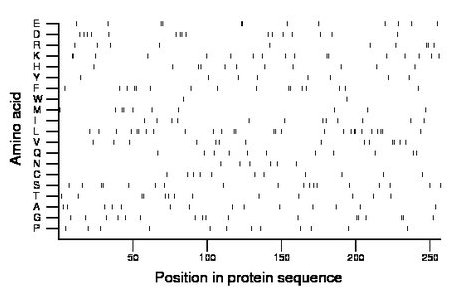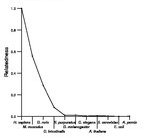
| Name: KCNMB3 | Sequence: fasta or formatted (257aa) | NCBI GI: 25952102 | |
|
Description: calcium-activated potassium channel beta 3 subunit isoform b
|
Referenced in:
| ||
Other entries for this name:
alt prot [279aa] calcium-activated potassium channel beta 3 subunit isoform d alt prot [277aa] calcium-activated potassium channel beta 3 subunit isoform a alt prot [275aa] calcium-activated potassium channel beta 3 subunit isoform c | |||
|
Composition:

Amino acid Percentage Count Longest homopolymer A alanine 5.4 14 1 C cysteine 4.3 11 1 D aspartate 6.2 16 2 E glutamate 4.7 12 2 F phenylalanine 6.2 16 2 G glycine 6.6 17 2 H histidine 4.3 11 1 I isoleucine 4.7 12 1 K lysine 6.6 17 2 L leucine 10.5 27 2 M methionine 3.9 10 2 N asparagine 2.3 6 1 P proline 4.7 12 1 Q glutamine 4.3 11 1 R arginine 3.9 10 2 S serine 7.0 18 2 T threonine 5.1 13 2 V valine 5.4 14 2 W tryptophan 0.8 2 1 Y tyrosine 3.1 8 1 |
Comparative genomics:
Search single species RefSeq proteins at NCBI
Search summary 
Figure data | ||
Related human proteins:Protein Relative score Description Self-match 1.000 calcium-activated potassium channel beta 3 subunit i... KCNMB3 0.996 calcium-activated potassium channel beta 3 subunit i... KCNMB3 0.996 calcium-activated potassium channel beta 3 subunit i... KCNMB3 0.996 calcium-activated potassium channel beta 3 subunit i... KCNMB2 0.312 calcium-activated potassium channel beta 2 subunit [... KCNMB2 0.312 calcium-activated potassium channel beta 2 subunit [H... KCNMB4 0.223 calcium-activated potassium channel beta 4 subunit [... KCNMB1 0.135 potassium large conductance calcium-activated channel... TRPV6 0.006 transient receptor potential cation channel, subfami...Human BLASTP results (used to prepare the table) | |||
Gene descriptions are from NCBI RefSeq. Search results were obtained with NCBI BLAST and RefSeq entries. When identical proteins are present, the self-match may not be listed first in BLASTP output. In such cases, the table above has been reordered to place it first.
See About the Figures for the scoring system used in the figure above right. The same scoring system was used in the table of BLASTP results.
Guide to the Human Genome
Copyright © 2010 by Stewart Scherer. All rights reserved.
